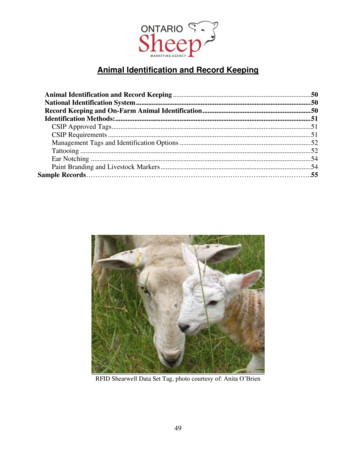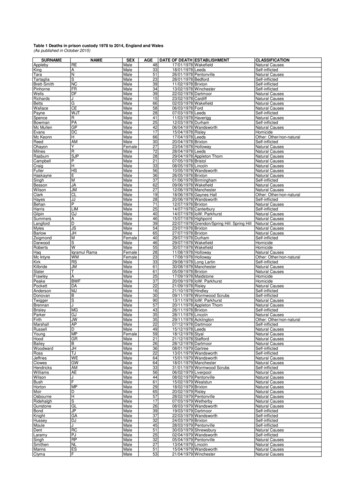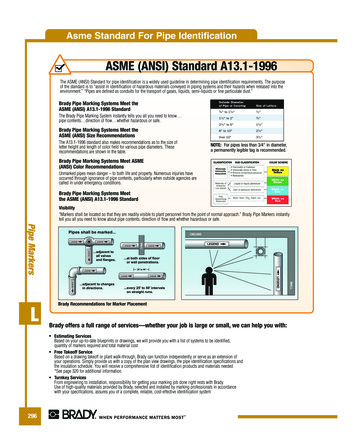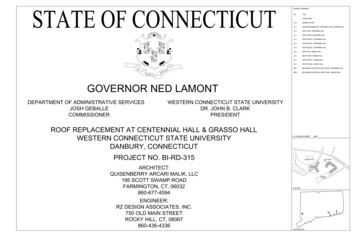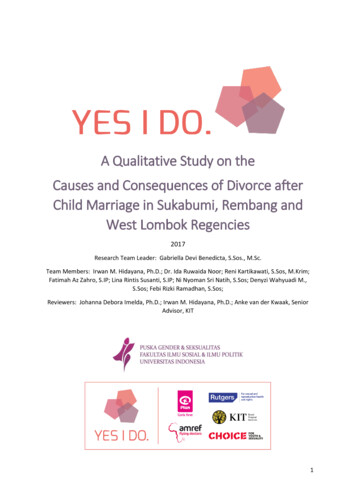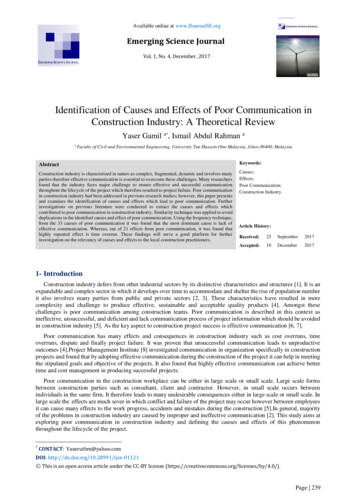
Transcription
Available online at www.IJournalSE.orgEmerging Science JournalVol. 1, No. 4, December, 2017Identification of Causes and Effects of Poor Communication inConstruction Industry: A Theoretical ReviewYaser Gamil a*, Ismail Abdul Rahman aaFaculty of Civil and Environmental Engineering, University Tun Hussein Onn Malaysia, Johor,86400, MalaysiaAbstractKeywords:Construction industry is characterized in nature as complex, fragmented, dynamic and involves manyparties therefore effective communication is essential to overcome these challenges. Many researchersfound that the industry faces major challenge to ensure effective and successful communicationthroughout the lifecycle of the project which therefore resulted to project failure. Poor communicationin construction industry had been addressed in previous research studies; however, this paper presentsand examines the identification of causes and effects which lead to poor communication. Furtherinvestigations on previous literature were conducted to extract the causes and effects whichcontributed to poor communication in construction industry. Similarity technique was applied to avoidduplications in the identified causes and effect of poor communication. Using the frequency technique,from the 33 causes of poor communication it was found that the most dominant cause is lack ofeffective communication. Whereas, out of 21 effects from poor communication, it was found thathighly repeated effect is time overrun. These findings will serve a good platform for furtherinvestigation on the relevancy of causes and effects to the local construction practitioners.Causes;Effects;Poor Communication;Construction Industry.Article r20171- IntroductionConstruction industry defers from other industrial sectors by its distinctive characteristics and structures [1]. It is anexpandable and complex sector in which it develops over time to accommodate and shelter the rise of population numberit also involves many parties from public and private sectors [2, 3]. These characteristics have resulted in morecomplexity and challenge to produce effective, sustainable and acceptable quality products [4]. Amongst thesechallenges is poor communication among construction teams. Poor communication is described in this context asineffective, unsuccessful, and deficient and lack communication process of project information which should be avoidedin construction industry [5]. As the key aspect to construction project success is effective communication [6, 7].Poor communication has many effects and consequences in construction industry such as cost overruns, timeoverruns, dispute and finally project failure. It was proven that unsuccessful communication leads to unproductiveoutcomes [4].Project Management Institute [8] investigated communication in organization specifically in constructionprojects and found that by adopting effective communication during the construction of the project it can help in meetingthe stipulated goals and objective of the projects. It also found that highly effective communication can achieve bettertime and cost management in producing successful projects.Poor communication in the construction workplace can be either in large scale or small scale. Large scale formsbetween construction parties such as consultant, client and contractor. However, in small scale occurs betweenindividuals in the same firm. It therefore leads to many undesirable consequences either in large scale or small scale. Inlarge scale the effects are much sever in which conflict and failure of the project may occur however between employeesit can cause many effects to the work progress, accidents and mistakes during the construction [5].In general, majorityof the problems in construction industry are caused by improper and ineffective communication [2]. This study aims atexploring poor communication in construction industry and defining the causes and effects of this phenomenonthroughout the lifecycle of the project.*CONTACT: Yaseruthm@yahoo.comDOI: http://dx.doi.org/10.28991/ijse-01121 This is an open access article under the CC-BY license e 239
Emerging Science Journal Vol. 1, No. 42- Literature ReviewPoor communication in construction industry (CI) has been investigated extensively by many researchers andconstruction practitioners. It attracted the concern of the studies due to its important in construction industry [7]. It isone of the main causes of project failure [9] subsequently it causes cost and time overruns in the form of reworkoccurrence [10] and miscommunication among construction parties [11].There are many forms and practices of poor communication in construction industry. Lack of frequentcommunication among construction parties is one of the forms of poor communication [12].A comparative study oncauses and effects of delay in Nigerian and Iranian construction projects by Oshodi & Rimaka [13] ranked lack ofcommunication between construction parties from the contactors perspective based on its importance as the 11th and12th for Nigeria and Iran respectively however the ranks from the consultant perspective were 20th and 13th for Nigeriaand Iran respectively. These results confirmed the significance of proper communication in the minimization of timeoverruns in construction projects.From another viewpoint, a study conducted by Darvik & Larsson [14] on the impact of material delivery deviationson costs and performance in construction projects showed that quality defects and delivery deviation of materialsoccurred due to lack of communication among relevant parties and communication failure. Therefore, it was suggested,stakeholders have to put more concern in the enhancement of communication regularity, means and methods.Communication skills are essential to produce effective communication however if the speaker lacks of these skillsthen poor communication may result. Interpersonal skills which include communication skills play an important role forthe success of a project [15]. Parties involve in construction possess different communication skills which also dependson their qualification and cultural background. These differences cause concurrent misunderstanding in the deliverystage [16].In construction industry, communication is managed by channels in all the organizations hence each department orsection in the organization is responsible of disseminating the related information to formulate complete communicationsystem However due to the complexity in construction industry several concurrent communication problems occurbecause no proper channelling is adopted to manage and control the communication process [17]. Lee & Bernold [11]reported that effective communication in construction is seriously hampered due to a lack of appropriate data channels,improper channel and inaccurate data transfers. Tipili et al [18] stated that, unclear channels of communications resultin project delay. It is therefore very important to standardize the channels of communication in construction industry tofasten and ease the communication process.Dispute is a common issue occurs in construction industry. It causes an impact on the main project components suchas cost, time and quality of construction projects [19]. Dispute is commonly known as an endemic and chronic characterof construction industry [20]. It was emphasized by many researchers; poor communication among construction industryis one of the main causative factors of dispute occurrence. It is therefore a major consequence of unsuccessfulcommunication. Kumaraswamy, [21] identified poor communication among construction parties as one of thesignificant causes of dispute. Lack of communication skills is considered of the utmost important diffusing factor tocause dispute in construction industry [22]. Therefore, effective communication is very important to improve therelationship between the project team [23].Time overrun is also known as delay which is referred as time beyond the completion date assigned in the contractduring the inception stage of construction [7, 21].Time overrun is classified as the most frequent problems inconstruction industry which in return causes adverse effects on the project success [24].Without proper communicationon the objective among stakeholders, it can cause delay [25]. Literatures have revealed that poor communication is oneof the main factors contributing to delay in construction [9]. Delay caused by poor communication can be in the formof slow information flow, improper communication channels, wrong design, wrong interpretation, reworks and etc. [7,18, 26, 27].Concept of cost overrun in construction industry means that the project failed financially to achieve its objective [9]Cost overrun occurs when project’s cost exceeds the contract sum and causing major conflict and litigation which mightextremely leads to project abandoned or failure [25]. A study by Alhomidan [28] in Saudi Arabia had identified 41 costoverrun factors in several road construction projects. It was found that, most of critical factors affecting cost overrunsare internal administrative difficulties, poor communication among construction parties, payments deferment, and delaysin decision making. In another investigation by Bassioni, Sarhan, and Zaki [3], it was found that lack of communicationand coordination between design participants of different background recorded higher relative impact to cost overrun indesign phase of Egyptian construction industry. This study extends the method of defining poor communication inconstruction industry by extracting the causes and effects of its existence in the industry.Page 240
Emerging Science Journal Vol. 1, No. 43- Methodology of the StudyIn this study, the method adopted is based on systematic reviews of previous literatures. Figure 1 illustrates the basicmethods used to carry out this study.Extracting causes and effects factors of poor communicationStage (1)Collection of academic articles on communication in CISimilarity check to eliminate repetition of factorsStage (2)Calculating frequency of each factorsAnalyzing the resultsConcluding remarks and recommendationsDrawing of conclusions and remarksFigure 1. Methodology of the study.3-1- Literature SearchRigorous investigation on previous literatures was carried out to extract the factors related to causes and effects ofpoor communication in construction industry. A total of more than 57 numbers articles which are associated with thesubject of poor communication in construction industry were analysed and scrutinized to identify the causes and effectsof poor communication in construction industry. These articles are basically academic and published documents.3-2- Similarity and Frequency AnalysisBased on these articles, causes and effects factors were extracted randomly and then these factors were analysedusing similarity checking and frequency analysis. Similarity analyses were performed to eliminate any repetition of anyfactor which has different phrase or synonyms and similar concept. Frequency analysis is a count of repetition of eachfactor appeared in different literature sources. This analysis is an initial assessment on the most recurring and repeatedfactors occurred in different literature and different construction projects to determine the level of significant of eachfactor. Table 1. shows an example of similarity analysis of one factor. It is obvious that, the factor existed in differentacademic articles with different phrases but carries similar meaning therefore a general term has to represent all thefactors that satisfy the meaning.Table 1. Illustration of Similarity Analysis.Causative Factors From Previous StudiesLack of good communication mechanismsLack of uniform standards for construction informationLack of communication systemIneffective reporting systemLack of feedback systemlack of appropriate data channelsReferencesAccepted Causative Factors[9,12,29]Lack of effective communicationsystem and platform[12,30][7,11,12,29,30,31,32][7, 32, 33][33][7,11]Page 241
Emerging Science Journal Vol. 1, No. 44- Result and DiscussionIn this study, an intensive investigation of academic articles which focused on the causes and effects factors of poorcommunication in construction industry therefore to understand the concern of researchers over the past 25 years it isimportant to demonstrate the development of studies of communication in construction industry.3027NO of 2006-20102011-2017YearFigure 2. No of Articles on Poor Communication in Construction Industry.Figure 2. shows the number of articles focusing on causative factors effects of poor communication in constructionindustry over the past 25 years. It is obvious that there are gradual increments over 26 years started from 2011 to 2017on the studies of communication in construction industry and this indicates that more concern on communication isrequired in line with the expansion of construction industry worldwide.In the following section, a tabulated findings of causes and effects factors of poor communication in constructionindustry are introduced to investigate the significance and the frequency of each factor. This helps draw a clearunderstanding of each factor and its significance to causing the problem.Table 2. Matrix of Causative Factors of Poor Communication and Their Frequencies.Causative FactorsReferencesFrequency1)Lack of effective communication between construction ,39,40]172)Lack of effective communication system and platform[7,9,11,12,,21,23,29,31,32,33]103)Poor communication skills[3,7,10,12,,27,29,38,39,41]94)Language barrier[7,10,15,27,42,43,44]75)Improper Communication channels[7,11,12,27,30,42]66)Possessing different level of education among construction teams[7,10,16,42]47)Lack of support for advanced communication technologies[7,10,16,42]48)Diversity of culture and ethics among construction teams[10,15,27,42]49)Personal barrier[7,10,42,45]410) Technology malfunction[7,12,16]311) Possessing differed skills levels among construction teams[10,15,16]312) Complexity of the construction industry[7,10,15]313) Lack of communication plan[11,12,21]314) lack of appropriate communications medium[7,11,32]315) Inaccessibility of information[46,47]216) Slow information flow between parties[9][45]217) frequent changes of project contract[7,29]218) improper communication time management[7,10]2Page 242
Emerging Science Journal Vol. 1, No. 419) Poor planning and coordination[7,32]220) poor communication management[6,7]221) lack of clear objectives[7,45]222) lack of mutual respect and trust among construction teams[7,46]223) Weak organizational structure[12]124) Inaccurate delivery of project information[11]125) unavailability of information in the time of need[47]126) Lack of communication procedure and training[46]127) contractual barrier[7]128) lack of adequate representation for project stakeholders[31]129) Lack of understanding among parties[45]130) Noise interruption[48]131) Poor detailed drawing[48]132) Incorrect instructions or technical information[44]133) Gender differences[46]1Table 2. shows a list of 33 identified causes of poor communication from previous studies and their repetitions knownas frequency which are used to determine individual cause considered by numbers of researchers. In Table 2, thefrequency is meant in the study by the number of repetitions of each factor in different articles. It is shown that, lack ofeffective communication between construction parties occurred 17 times in different literature following that, lack ofeffective communication system and platform which has occurred 10 times poor communication skills which occurred9 times. It is rectified those factors have played significant cause in the phenomenon of poor communication inconstruction industry. This illustrates the significant need of construction industry to take immediate concern inimproving the current state of communication.Table 3. Matrix of Effects Factors of Poor Communication and Their Frequencies.Effects factorsReferenceFrequency1)Time overrun2)Conflict among construction 7][58][18][59][60][61][62]3)Cost overrun[27][36][50][51][18][16][9][64]84)Rework and redesign occurrence[7][10][18][54][26][18][59]75)High accident rate[49][18][53][20][57]56)Failure of the project[7][21][63][65][66]57)Demotivated workforces[7][12][10][18][31]58)Poor team work[10][16][18][66]49)Late response to disaster[7][51][54][56]410)Low ][18]312)Misinterpretation[10][16][18]313)Design errors[27][18][20]314)Low Level of satisfaction among construction parties[27][18][20]215)Frequent remedies in design and planning schedule[7][25]216)Waste generation[67][64]217)Unclear channels[7]118)Poor risk management[18]119)Poor project documentation[57]120)Poor planning[68]121)Affects design process[68]11914Table 3. shows 21 effects factors resulted from the problem of poor communication in construction industry. It alsolists the effects factors of poor communication in construction industry with their frequencies. It is shown that, the mostrepeated effect is time overrun which appears 19 times previous literatures. Second most effect is cost overrun whichPage 243
Emerging Science Journal Vol. 1, No. 4appeared 8 times. That shows how poor communication can have high negative effects on cost and time overruns inconstruction industry. It was confirmed that, poor communication among construction parties is considered one of theleading factors to cause cost and time overruns.5- ConclusionIt is concluded that, poor communication phenomenon in construction industry is a major issue faced in all theconstruction industries around the world therefore achieving successful communication is a major challenge inconstruction industry due to the diversity and changing nature of construction projects. To enhance communication inconstruction industry, several measures and methods have to be taken to minimize the causes and effects factors.Basically, effects are results of causes hence eliminating the causes can results in zero effects. In this study, the causativeand effects factors were identified from literature. Through literature, 33 causes and 21effects were identified. The mostrecurring causes were lack of effective communication among construction parties following with poor communicationskills. Furthermore, the most recurring effect was time overruns and consecutively cost overruns. The factors identifiedwill be used to carry out a survey to construction practitioners in order to assess their importance and severity towardthe occurring of poor communication in construction industry.6- AcknowledgementThe authors acknowledge the financial assistance provided by ministry of higher education in Yemen and researchsupports provided by University Tun Hussein Onn Malaysia.7- References[1] Anna Dubois & Lars-Erik Gadde “the construction industry as a loosely couple system: implications for productivity andinnovation”, Construction Management and Economics, (2002) 20:7, 621-631, DOI: 10.1080/01446190210163543.[2] Kazi, A. S.”Knowledge management in the construction industry: A socio-technical perspective”. IGI Global. Technology &Engineering (2005).[3] Abd El-Razek, M. E., Bassioni, H. A., & Mobarak, A. M. “Causes of delay in building construction projects in Egypt”. Journalof Construction Engineering and Management, (2008)133(11), 831-841.[4] Teo.W.M “Communication: Information Management in the Construction Industry”. University of South Australia. (1991).[5] Berntzen, P. “Communication and related work problems in the construction industry”. University of Texas at Austin. (1988).[6] Emmitt, S., & Gorse, C. “Communication in construction teams”. Taylor & Francis. London. (2006).[7] Dainty, A, Moore, D and Murray, M “Communication in construction: Theory and practice”, Taylor & Francis, London. (2006).[8] Press Releases “Project Management Institute (PMI)” more than half of all project budget risk is due to ineffectivecommunications” retrieved from (www.pmi.org).(March, 2013).[9] Abdul Rahman, I., Memon, A. H., Karim, A., & Tarmizi, A. “Significant factors causing cost overruns in large constructionprojects in Malaysia”. Journal of Applied Science, (2013) 13(2), 286-293.[10] Emuze, F., & James, M. “Exploring communication challenges due to language and cultural diversity on South Africanconstruction sites”. Acta Structilia, (2013)20(1), 44-65.[11] Lee, J., & Bernold, L. E. “Ubiquitous agent-based communication in construction”. Journal of Computing in Civil Engineering,(2008) 22(1), 31-39.[12] Tai, S., Wang, Y., & Anumba, C. J. “A survey on communications in large-scale construction projects in China. Engineering”Construction and Architectural Management, (2009)16(2), 136-149.[13] Oshodi Olalekan, S., & Iyagba Rimaka “A comparative study on causes and effects of delay in Nigerian and Iranian constructionprojects”. Asian Journal of Business and Management Sciences .Vol. 3 No. 01 [29-36] (2013).[14] Darvik, L., & Larsson, J. “The Impact of Material Delivery-Deviations on Costs and Performance in Construction Projects”.Master’s Thesis in the Design and Construction Project Management. Chalmers University of technology. Sweden. (2010).[15] Gunhan, S., Senol, G., & Dogan, S. Z. “Non-verbal cues: improving communication in construction projects”. American Societyfor Engineering Education. (2012).[16] Cheng, Eddie WL, Heng Li, Peter ED Love, and Zahir Irani. "Network communication in the construction industry." CorporateCommunications: An International Journal 6, no. 2 (2001): 61-70.[17] Fichet, H., & Giraud, L. “How the information flow is processed in project-based companies compared to others and how itaffects strategic drift”. Master thesis. UMEA school of business .Sweden. (2007).Page 244
Emerging Science Journal Vol. 1, No. 4[18] Luka Goji Tipili, Patricia Oyiza Ojeba and Muhammad Sa'adiya Ilyasu “Evaluating the effects of communication in constructionproject delivery in Nigeria”. Global Journal of Environmental Science and Technology: ISSN-2360-7955, Vol. 2(5): pp 048-054,June, 2014.[19] Gebken, R. J., & Gibson, G. E. “Quantification of costs for dispute resolution procedures in the construction industry”. Journalof professional issues in engineering education and practice, (2006) 132(3), 264-271.[20] Sinha, M., & Wayal, A. S. “Dispute Causation in Construction Projects”. IOSR Journal of Mechanical and Civil Engineering(IOSR-JMCE). (2007).[21] Chan, D. W., & Kumaraswamy, M. M. “A comparative study of causes of time overruns in Hong Kong construction projects”.International Journal of project management, (1997).15(1), 55-63.[22] Loosemore, M., & Muslmani, H. A. “Construction project management in the Persian Gulf: inter-cultural communication”.International Journal of Project Management, (1999)17(2), 95-100.[23] Adnan Enshassi Jomah Al-Najjar Mohan Kumaraswamy, “Delays and cost overruns in the construction projects in the GazaStrip", Journal of Financial Management of Property and Construction, (2009) Vol. 14 Iss 2 pp. 126 – 151.[24] Faridi, A. S., & El‐Sayegh, S. M. “Significant factors causing delay in the UAE construction industry”. ConstructionManagement and Economics, (2006) 24(11), 1167-1176.[25] Oluwaseun Sunday, D., & Olumide Afolarin, A. “Causes, effects and remedies of errors in Nigerian construction documents”.Organization, Technology & Management in Construction: An International Journal, (2013) 5(1), 676-686.[26] Love, P. E., & Li, H. “Quantifying the causes and costs of rework in construction”. Construction Management & Economics,(2000) 18(4), 479-490.[27] Sambasivan, M., & Soon, Y. W. “Causes and effects of delays in Malaysian construction industry”. International Journal ofproject management, (2007) 25(5), 517-526.[28] Alhomidan, A. “Factors affecting cost overrun in road construction projects in Saudi Arabia”. International Journal of Civil &Environmental Engineering, IJEE-IJENS, (2010)13(3).[29] Enshassi, A., Al-Hallaq, K., & Mohamed, S.” Causes of contractors’ business failure in developing countries: the case ofPalestine”. Journal of construction in developing countries, (2006) 11(2), 1-14.[30] Ahuja, Vanita and Yang, Jay and Shankar, Ravi “Web Based Communication for Construction Project Management”. InProceedings World Conference on Accelerating Excellence in the Built Environment. (2006).[31] Thomas, S., Tucker, R., and Kelly, W. “Critical communications variables.” J. Constr. Eng. Manage., 129, 1, 58–66. (1998).[32] Bandulahewa, B. K. M. “Effective project communication for construction project managers in Sri Lanka”. Master thesis,University of Moratuwa Sri Lanka. (2015).[33] Nguyen, T. P., & Chileshe, N. “Revisiting the Critical Factors Causing Failure of Construction Projects in Vietnam”. (Doctoraldissertation, Association of Researchers in Construction Management). (2013).[34] Kasimu, M. A., & Abubakar, D. I. “Causes of delay in Nigeria construction industry”. The Journal of contemporary research inbusiness, 4(2). (2012).[35] Tumi, S. A. H., Omran, A., & Pakir, A. H. K. “Causes of delay in construction industry in Libya”. In the International Conferenceon Economics and Administration (pp. 265-272). (2009, November).[36] Hoezen, M. E. L., Reymen, I. M. M. J., & Dewulf, G. P. M. R. “The problem of communication in construction”. (Paperpresented at the CIB W96 Adaptable Conference, University of Twente). (2006).[37] Assah-Kissiedu, M., Fugar, F. D. K., & Badu, E.” Triggers of disputes within the Ghanaian construction industry”. InProceedings 5th Built Environment Conference (2010, July). (Vol. 18, p. 20).[38] Mezher, T. M., & Tawil, W. “Causes of delays in the construction industry in Lebanon”. Engineering, Construction andArchitectural Management, 5(3), 252-260. (1998).[39] Doloi, H., Sawhney, A., Iyer, K. C., & Rentala, S.” Analyzing factors affecting delays in Indian construction projects”.International Journal of Project Management, 30(4), 479-489. (2012).[40] Laihonen, H., Vuolle, M., & Käpylä, J. “Negative Customer Experiences and Intellectual Liabilities in Construction Industry”.In Proceedings of the 11th International Conference on Intellectual Capital, Knowledge Management and Organizational Learning:ICICKM2014 (p. 274). Academic Conferences Limited. (2014, October).[41] M. Haseeb, LuXinhai, Aneesa Bibi, Qazi Gulam Raqeeb. “A case study on: Importance of Delay Causes in Construction Projectsof Pakistan”. Asian Journal of Business and Management Sciences ISSN: 2047-2528 (2012) Vol. 1 No. 10 [94-101], www.ajbms.org.Page 245
Emerging Science Journal Vol. 1, No. 4[42] Loosemore, M., & Lee, P. “Communication problems with ethnic minorities in the construction industry”. International Journalof Project Management, 20(7), 517-524. (2002).[43] Ali, A. S., & Wen, K. H.” Building defects: Possible solution for poor construction workmanship”. Journal of BuildingPerformance, 2(1). (2011).[44] Waziri, F., & Khalfan, S. “Cross-Cultural Communication in Construction Industry: How do Chinese Firms Cross the Barriersin Tanzania”. European Journal of Business and Management, 6(13), 118-122. (2014).[45] Baguley, Phil “Effective communication for modern business”. McGraw-Hill, London; New York. (1994).[46] Khahro, S. H., & Ali, T. H. “Causes Leading to Conflicts in Construction Projects: A Viewpoint of Pakistani ConstructionIndustry”. International Conference on challenges in IT, Engineering and Technology (ICCIET’2014) July 17-18, 2014 Phuket(Thailand).[47] Thorpe, T., & Mead, S. “Project-specific web sites: Friend or foe?” Journal of Construction Engineering and Management.(2001).[48] Aulich, T. “The role of effective communication in the construction Industry: a guide for education and health clients”.Australasian Journal of Construction Economics and Building, 13 (4) 92-101. (2013).[49] Sadi Assaf, Mohammad A. Hassanain and Salman Al-Zahrani X”Causes of Contractors’ Failure in Industrial Projects in SaudiArabia” Research Journal of Applied Sciences, Engineering and Technology 9(3): 158-164, 2015 ISSN: 2040-7459; e-ISSN: 20407467. (2012)[50] Gidado, Kassim and Niazai, Ghulam “Causes of project delay in the construction industry in Afghanistan”: EPPM2012,University of Brighton, UK, 10-11th September, (2012)[51] Apolot, R., Alinaitwe, H., & Tindiwensi, D.” An investigation into the causes of delay and cost overrun in Uganda’s publicsector construction projects”. In Second International Conference on Advances in Engineering and Technology (pp. 305-311). (2011).[52] Mydin, M. O., Sani, N. M., Salim, N. A., & Alias, N. M. “Assessment of Influential Causes of Construction Project Delay inMalaysian Private Housing from Developer’s Viewpoint”. In E3S Web of Conferences (Vol. 3, p. 01027). EDP Sciences. (2014).[53] Al‐Kharashi, A., & Skitmore, M. “Causes of delays in Saudi Arabian public sector construction projects”. ConstructionManagement and Economics, (2009) 27(1), 3-23.[54] Liao, P. C., Lei, G., Fang, D., & Liu, W. “The relationship between communication and construction safety climate in China”.KSCE Journal of Civil Engineering, 18(4), 887-897. (2014).[55] Lo, T. Y., Fung, I. W., & Tung, K. C. “Construction delays in Hong Kong civil engineering projects”. Journal of ConstructionEngineering and Management, 132(6), 636-649. (2006).[56] Kikwasi, G. “Causes and effects of delays and disruptions in construction projects in Tanzania”. In Australasian Journal ofConstruction Economics and Building-Conference Series (Vol. 1, No. 2, pp. 52-59). (2013, February).[57] Cerić, A. “The impact of asymmetric information on communication risk in construction projects”. In
Communication skills are essential to produce effective communication however if the speaker lacks of these skills then poor communication may result. Interpersonal skills which include communication skills play an important role for the success of a project [15]. Parties involve in construction possess different communication skills which also .


